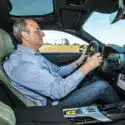Three-pointed start
First Mercedes-powered Aston offers a taste of the future
– Aston Martin DB11 V8 –
Since the war, how many engines has Aston Martin designed from scratch by itself? I count two. The sixes used up until 1959 were created by Lagonda, after which came Tadek Marek’s straight six and V8 motors that served in many different forms from 1959 to the turn of the century. Everything since the DB7 has had its origins in other people’s designs, specifically those of Ford, Jaguar and, lest we forget the Cygnet, Toyota.
Well, we can now add Mercedes-Benz to their number.
Deciding to slip Mercedes’ 4-litre V8 in the space under the DB11’s bonnet designed for Aston’s 5.2-litre V12 must have been easy indeed.
The engine has a superb reputation and was already heading for the new Vantage whose platform the DB11 shares, so it was simple to fit. And it would provide a chance to bridge the gap between the Vantage and V12 DB11 not just in terms of money, but conceptually too.
The V8 engine is far lighter, more sporting in nature than the languid V12 and provides a more rearward weight distribution, so a sharper yet scarcely slower DB11 should be the result.
And so it proves. To look at this car as simply a more affordable DB11 is to miss its point entirely. In the way it offers Grand Touring ability but with a real dynamic edge, to me it is the very embodiment of a modern DB4.
Indeed this is the most broadly capable Aston Martin I have yet driven, the V12 included. Because it is 115kg lighter and comes with sharper suspension and steering whose development has moved on even from where it was with the V12 DB11, it has an edge its bigger-engined brother lacks.
I spent a considerable amount of time flinging it around a soaking wet Castle Combe – a difficult enough circuit even when dry – and it kept me amazed and amused in equal measure throughout. On the road it is poised, responsive and comes with a soundtrack almost as enticing as that of the yowling V12. Make no mistake – Mercedes engine or not, this is a car full of the Aston spirit.
And yet were it me, I think I’d probably still try to find the extra and buy the V12.
It sounds perverse – particularly as the V8 is probably more true to the Aston Martin philosophy – but if you’re going to buy a long-distance Aston, why not the one with the quietest cabin, the softest ride and, you bet, the biggest engine?
There is something unique in the smoothness and voice of a 12-cylinder motor that simply cannot be expressed on paper, but which is no less important for that; it is why almost all the blue-bloods from Ferrari to Rolls-Royce and Aston Martin to Bentley still use them.
So while the V8 is probably the better Aston Martin, the V12 is the even greater GT. The good news is that it’s an enviable choice with no wrong answer, though one I am sadly in no position to make.
FACTFILE
Aston Martin DB11 V8
Price £144,900 approx Engine 4.0 litres, 8 cylinders, turbocharged Power 502bhp@6000rpm Torque 497lb ft@2000rpm Weight 1760kg Power to weight 285bhp per tonne Transmission eight-speed automatic, rear-wheel drive 0-60mph4.0sec Top speed 187mph Economy 28.5mpg CO2 230g/km

